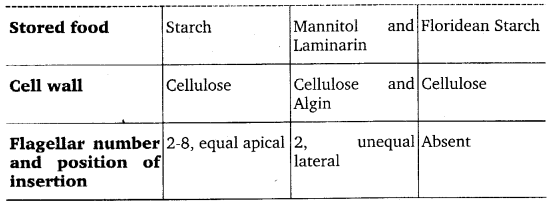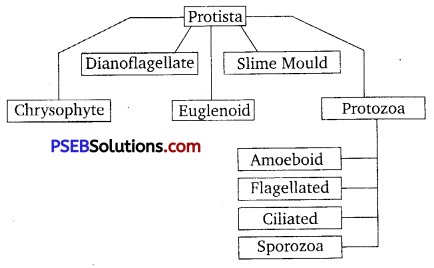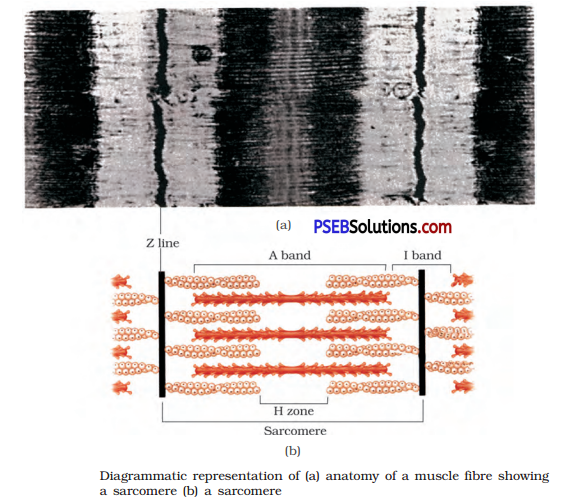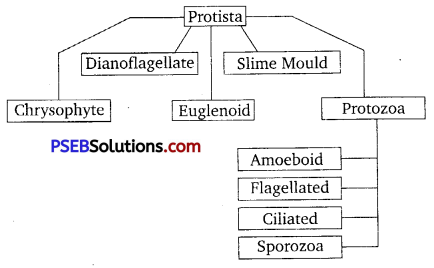Punjab State Board PSEB 11th Class Biology Book Solutions Chapter 19 Excretory Products and their Elimination Textbook Exercise Questions and Answers.
PSEB Solutions for Class 11 Biology Chapter 19 Excretory Products and their Elimination
PSEB 11th Class Biology Guide Excretory Products and their Elimination Textbook Questions and Answers
Question 1.
Define Glomerular Filtration Rate (GFR).
Answer:
Glomerular Filtration Rate (GFR) is the amount of the filtrate formed by the kidneys per minute. GFR in a healthy individual is approximately 125 mt/mm, i.e., 180 L day.
Question 2.
Explain the autoregulatory mechanism of GFR.
Answer:
Regulation of GFR: The kidneys have built-in mechanisms for the regulation o glomerular filtration rate. One such efficient mechanism is carried out by the juxtaglomerular apparatus (JGA). JGA is a special sensitive region formed by cellular modifications in the distal convoluted tubule and the afferent arteriole at the location of their contact. A fall in GFR can activate the JG cells to release renin which can stimulate the glomerular blood flow and thereby the GFR back to normal.
Question 3.
Indicate whether the following statements are true or false:
(a) Micturition is carried out by a reflex.
(b) Al)H helps In water elimination, making the urine hypotonia.
(c) Protein-free fluid is filtered from blood plasma into the Bowman’s capsule.
(d) Henle’s loop plays an important role in concentrating the urine.
(e) Glucose is actively reabsorbed in the proximal convoluted tubule.
Answer:
(a) True,
(b) False,
(C) True,
(d) True,
(e) True.
![]()
Question 4.
Give a brief account of the counter-current mechanism.
Answer:
Counter-current Mechanism
- The counter-current mechanism takes place in Henle’s loop and vasa recta.
- The flow of filtrate in the two limbs of Henle’s loop is in opposite directions and thus, forms a counter-current.
- The flow of blood through the two limbs of vasa recta is also in a counter-current pattern.
- NaCl is transported by the ascending limb of Henle’s loop which is exchanged with the descending limb of vasa recta.
- NaCl is returned to the interstitium by the ascending portion of vasa recta.
- Similarly small amount of urea enters the thin segment of the ascending limb of Henle’ loop, which is transported back to the interstitium by the collecting tubule.
- This transport of substances facilitated by the special arrangement of Henle’s loop and vasa recta is called the counter-current mechanism,
- It helps to maintain a concentration gradient in the medullary interstitium, which facilitates an easy passage of water from the collecting tubule thereby concentrating the filtrate (urine).
Question 5.
Describe the foie of liver, lungs and skin in excretion.
Answer:
Liver, lungs and skin also play an important role in the process of excretion. Role of the Liver: Liver is the largest gland in vertebrates. It helps in the excretion of cholesterol, steroid hormones, vitamins, drugs, and other waste materials through bile. Urea is formed in the liver by the ornithine cycle. Ammonia-a toxic substance is quickly changed into urea in the liver and thence eliminated from the body. Liver also changes the decomposed haemoglobin pigment into bile pigments called bilirubin and biliverdin.
Role of the Lungs: Lungs help in the removing waste materials such as carbon dioxide from the body.
Role of the Skin: Skin has many glands which help in excreting waste products through pores. It has two types of glands-sweat and sebaceous glands.
Sweat glands are highly vascular and tubular glands that separate the waste products from the blood and excrete them in the form of sweat. Sweat excretes excess salt and water from the body.
Sebaceous glands are branched glands that secrete an oily secretion called sebum.
Question 6.
Explain micturition.
Answer:
Micturition: The process of release of urine is called micturition and the neural mechanisms causing it is called the micturition reflex. An adult human excretes on an average 1 to 1.5 L of urine per day. The urine formed is a light yellow coloured watery fluid which is slightly acidic (pH 6.0) and has a characteristic odour.
Question 7.
Match the items of Column-I with those of Column-II:
| Column-I | Column-II |
| (a) Ammonotelism | (i) Birds |
| (b) Bowman’s capsule | (ii) Water reabsorption |
| (c) Micturition | (iii) Bony fish |
| (d) Uricotelism | (iv) Urinary bladder |
| (e) ADH | (v) Renal tubule |
Answer:
| Column-I | Column-II |
| (a) Ammonotelism | (iii) Bony fish |
| (b) Bowman’s capsule | (v) Renal tubule |
| (c) Micturition | (iv) Urinary bladder |
| (d) Uricotelism | (i) Birds |
| (e) ADH | (ii) Water reabsorption |
Question 8.
What is meant by the term osmoregulation?
Answer:
It is the phenomenon of regulation of change in the concentration of body fluids according to the concentration of external environment. Le., most marine invertebrates, some freshwater invertebrates, hagfish (a vertebrate).
Question 9.
Terrestrial animals are generally either republic or uricotelic, not ammonotelic, why?
Answer:
Terrestrial adaptation requires the production of less toxic nitrogenous wastes like urea and uric acid for the conservation of water. Aquatic animals excret atnmonia which requires large amounts of water to dissolve. This huge quantity of water is easily available to such animals from surroundings.
However, for terrestrial animals, such a huge quantity of water is not available, hence, they modify their original water product NH3 to comparatively less toxic products like urea and uric acid which requires less amount of water for their excretion.
![]()
Question 10.
What is the significance of juxtaglomerular apparatus (JGA) in Sidney function?
Answer:
The juxtaglomerular apparatus (JGA) plays an important role in monitoring and regulation of kidney functioning by hormonal feedback, mechanism, involving the hypothalamus and to a certain extent, the heart.
Question 11.
Name the following:
(a) A chordate animal having flame cells as excretory structures.
(b) Cortical portions projecting between the medullary pyramids in the human kidney.
(c) A loop of capillary running parallel to the Henle’s loop.
Answer:
(a) Flarworms,
(b) Columns of Bertini,
(c) Vasa recta
Question 12.
Fill in the gaps:
(a) Ascending limb of Henle’s loop is ………………………… to water whereas the descending limb is …………………….. to it.
(b) Reabsorption of water from distal parts of the tubules is facilitated by hormone ……………………………. .
(c) Dialysis fluid contains all the constituents as in plasma except …………………………… .
(d) A healthy adult human excretes (on an average) ………………………… gm of urea/day.
Answer:
(a) impermeable, permeable;
(b) vasopressin or ADH.;
(c) the nitrogenous wastes;
(d) 25-30.





